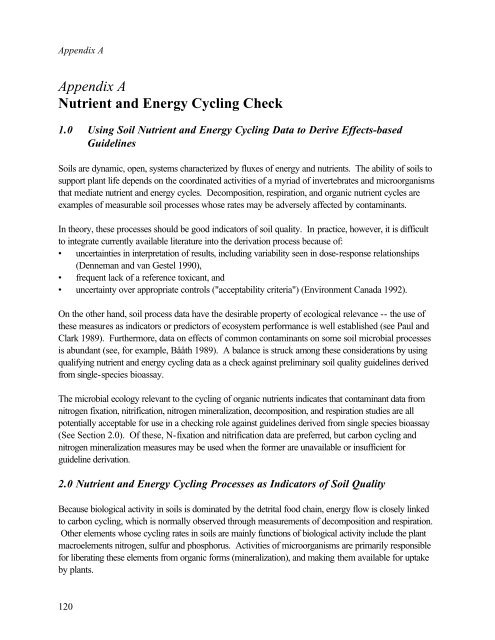Protocol for the Derivation of Environmental and Human ... - CCME
Protocol for the Derivation of Environmental and Human ... - CCME
Protocol for the Derivation of Environmental and Human ... - CCME
You also want an ePaper? Increase the reach of your titles
YUMPU automatically turns print PDFs into web optimized ePapers that Google loves.
Appendix A<br />
Appendix A<br />
Nutrient <strong>and</strong> Energy Cycling Check<br />
1.0 Using Soil Nutrient <strong>and</strong> Energy Cycling Data to Derive Effects-based<br />
Guidelines<br />
Soils are dynamic, open, systems characterized by fluxes <strong>of</strong> energy <strong>and</strong> nutrients. The ability <strong>of</strong> soils to<br />
support plant life depends on <strong>the</strong> coordinated activities <strong>of</strong> a myriad <strong>of</strong> invertebrates <strong>and</strong> microorganisms<br />
that mediate nutrient <strong>and</strong> energy cycles. Decomposition, respiration, <strong>and</strong> organic nutrient cycles are<br />
examples <strong>of</strong> measurable soil processes whose rates may be adversely affected by contaminants.<br />
In <strong>the</strong>ory, <strong>the</strong>se processes should be good indicators <strong>of</strong> soil quality. In practice, however, it is difficult<br />
to integrate currently available literature into <strong>the</strong> derivation process because <strong>of</strong>:<br />
• uncertainties in interpretation <strong>of</strong> results, including variability seen in dose-response relationships<br />
(Denneman <strong>and</strong> van Gestel 1990),<br />
• frequent lack <strong>of</strong> a reference toxicant, <strong>and</strong><br />
• uncertainty over appropriate controls ("acceptability criteria") (Environment Canada 1992).<br />
On <strong>the</strong> o<strong>the</strong>r h<strong>and</strong>, soil process data have <strong>the</strong> desirable property <strong>of</strong> ecological relevance -- <strong>the</strong> use <strong>of</strong><br />
<strong>the</strong>se measures as indicators or predictors <strong>of</strong> ecosystem per<strong>for</strong>mance is well established (see Paul <strong>and</strong><br />
Clark 1989). Fur<strong>the</strong>rmore, data on effects <strong>of</strong> common contaminants on some soil microbial processes<br />
is abundant (see, <strong>for</strong> example, Bååth 1989). A balance is struck among <strong>the</strong>se considerations by using<br />
qualifying nutrient <strong>and</strong> energy cycling data as a check against preliminary soil quality guidelines derived<br />
from single-species bioassay.<br />
The microbial ecology relevant to <strong>the</strong> cycling <strong>of</strong> organic nutrients indicates that contaminant data from<br />
nitrogen fixation, nitrification, nitrogen mineralization, decomposition, <strong>and</strong> respiration studies are all<br />
potentially acceptable <strong>for</strong> use in a checking role against guidelines derived from single species bioassay<br />
(See Section 2.0). Of <strong>the</strong>se, N-fixation <strong>and</strong> nitrification data are preferred, but carbon cycling <strong>and</strong><br />
nitrogen mineralization measures may be used when <strong>the</strong> <strong>for</strong>mer are unavailable or insufficient <strong>for</strong><br />
guideline derivation.<br />
2.0 Nutrient <strong>and</strong> Energy Cycling Processes as Indicators <strong>of</strong> Soil Quality<br />
Because biological activity in soils is dominated by <strong>the</strong> detrital food chain, energy flow is closely linked<br />
to carbon cycling, which is normally observed through measurements <strong>of</strong> decomposition <strong>and</strong> respiration.<br />
O<strong>the</strong>r elements whose cycling rates in soils are mainly functions <strong>of</strong> biological activity include <strong>the</strong> plant<br />
macroelements nitrogen, sulfur <strong>and</strong> phosphorus. Activities <strong>of</strong> microorganisms are primarily responsible<br />
<strong>for</strong> liberating <strong>the</strong>se elements from organic <strong>for</strong>ms (mineralization), <strong>and</strong> making <strong>the</strong>m available <strong>for</strong> uptake<br />
by plants.<br />
120
















